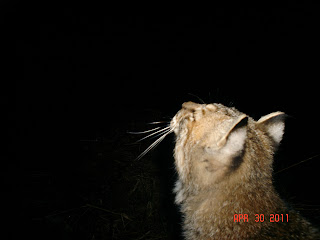Back at one of my favorite logs, this camera was set up for otters and I got what I asked for on this one. Upon approach, I noticed an otter latrine (a group of scats together used for marking), and it looked as if otters had been near my camera. The camera was placed just a foot to close to the log so I moved it back and will wait for the otters return. All otter visits were in the evening or the early morning. A porcupine and a number of raccoons were also some of the visitors.
Tuesday, February 28, 2012
Wednesday, February 8, 2012
The First Lynx
 |
| My favorite picture of the lynx- a male, pausing to check out the scents I had put down over a months earlier. |
A good friend and local biologist saw a lynx in Pittsburg N.H. earlier this summer, but with no photo's to show, there wasn't the proof needed to confirm this species. A few transient lynx have passed through NH in the last decade, evidence that has been found in tracks, but the last known NH lynx was killed by a car in 1993.
In mid July I began to set up the cameras I built in Pittsburg N.H., using many of the same tricks that I had used for bobcat. I checked my cameras at the end of July, in August, and then again in early September. I added a few cameras and moved them around to put the most reliable cameras in the best locations. Essentially I was focusing on the best snowshoe hare habitat, the Lynx's primary food--as confirmed by many scat analysis studies in Maine and southern Quebec.
Checking and deploying the cameras is a full two-day job, sunrise to sun set. In November, after 4.5 months, and over 10,000 photographs, I had the pictures of a lynx that I wanted. The picture above is one such example, and is to my knowledge the first picture of a wild lynx in New Hampshire habitat ever. I have exhausted all of my sources in search of another photograph of a lynx in NH, and it seems unlikely to me, after talking with biologists, scholars, and examining the history of lynx in N.H., that such a photograph exists. When I check them cameras again in another month or so, I will be trying a few new tricks that I picked up from some old trappers, and I believe these new techniques will make my camera sets very successful. Look for new pictures that will be posted here in the coming months, meanwhile I have deployed enough local cameras in some of my favorite spots to keep the pictures coming until then. A special thank-you to all of those who have supported my efforts, they would not be possible without the support and constant information from those at home an on the web.
Here is the link to the published article by N.H. Fish and Game:
Wednesday, February 1, 2012
The cat call
Cats, like other animals respond to a number of stimuli in order to find prey, avoid predators, etc. As a wildlife photographer, I try to think about what what senses make the animal I want to capture so successful, and use them to my advantage. In a basic sense: how does the animal see the world. In the "cat world" audio and visual stimuli can entice a cat's curiosity to come in close. In my experience for Canines it's all about smell, where as cats you use a visual attractor to get them to the site, and scent to hold them there, for canines scent can do both. It doesn't have to be something expensive, just something out of the ordinary, like a feather or a CD that will dance in the gentlest breeze.
On this set I had an audio caller playing at dark at 30 second intervals. I was expecting to get photo's of the cat coming in to the camera, but didn't expect him to sit down in front of it. I will have to change the camera placement next time I use the technique. On another note, this is a perfect example of why you should turn the time/date stamps off of your camera. The time/date is automatically stored in the file data and can ruin a nice picture if you choose to display it. Lesson learned.
Subscribe to:
Posts (Atom)









